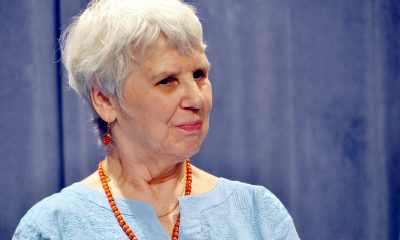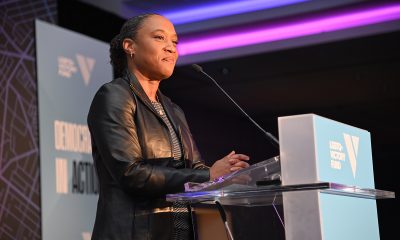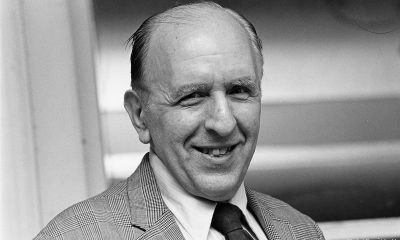Local
Kameny’s ashes remain in storage
Cemetery president proposes end to burial impasse
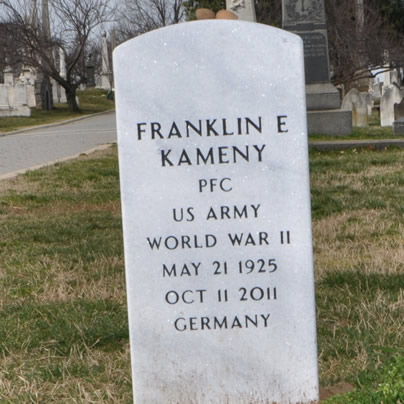
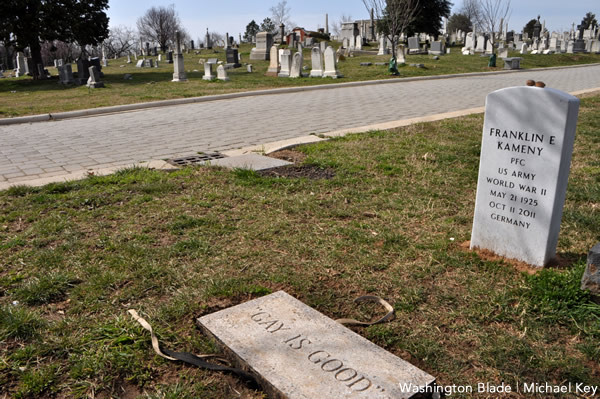
A headstone and a separate marker inscribed with Frank Kameny’s famous slogan ‘Gay is Good’ have been removed from his gravesite in Congressional Cemetery. (Blade photo by Michael Key)
Nearly 10 months after nationally acclaimed gay rights leader Frank Kameny died in his Washington home at the age of 86, an urn bearing his ashes continues to sit on a shelf in a storage vault in the headquarters building of D.C.’s historic Congressional Cemetery.
Cemetery officials said a dispute between Kameny’s estate and the D.C. gay charitable group Helping Our Brothers and Sisters (HOBS) over ownership rights to the plot where Kameny’s ashes were scheduled to be interred on March 2 forced the cancellation of the interment. HOBS purchased the plot earlier this year without consulting the estate, a development that the estate’s attorney says triggered the dispute.
The ashes, along with a headstone provided by the U.S. Veterans Administration recognizing Kameny’s military service during World War II and a separate marker inscribed with Kameny’s famous slogan “Gay is Good” have languished in storage at the cemetery since shortly after the interment was cancelled.
But in a surprise development on Wednesday, Congressional Cemetery’s new president, Paul Williams, disclosed in an email to the estate and HOBS that HOBS never had legal ownership rights to the Kameny plot because it failed to pay the balance on the purchase price.
“Because it had a balance, no deed was issued for the site to HOBS,” Williams said in his email.
“I propose we issue the deed directly to the estate (copy to HOBS) showing proof of ownership,” he wrote. “The estate would also need to sign an authorization of interment, which can be done at the same time. Then, we can replace the two stones in storage that we also have onsite and proceed with a private interment,” Williams wrote.
Glen Ackerman, an attorney representing the estate on behalf of Timothy Clark, whom Kameny named in his will as the main beneficiary of the estate, said the estate has accepted Williams’ proposal.
He said Williams’ disclosure that HOBS never had a deed to the cemetery plot and that the cemetery would issue the deed to the estate effectively ends the dispute by turning over the plot to Clark and the estate.
HOBS President Marvin Carter couldn’t immediately be reached Wednesday afternoon to comment on Williams’ disclosure that the cemetery planned to issue to the Kameny estate the deed to the cemetery plot.
Ackerman has said all along that the dispute centered on the estate’s desire to own the cemetery plot to ensure, among other things, that no one else would be buried or interred in the plot.
Under cemetery rules, two coffins and three urns may be buried or interred in Congressional Cemetery plots.
HOBS, which purchased the cemetery plot earlier this year from money donated by Kameny’s friends and admirers, has said it had no intention of burying others at the site.
Carter has said he and HOBS were always willing to transfer ownership of the plot to the estate. But people familiar with the dispute have said the point of contention was whether the estate should reimburse HOBS for the purchase price of the plot.
Ackerman has said Clark’s position was that donors from the LGBT community put up the money to buy the plot by giving it to HOBS, a non-profit group with tax-exempt status, so the donors could receive a tax deduction on their contribution. HOBS, in turn, made the purchase on behalf of the donors, the estate has maintained.
Meanwhile, the cemetery’s former interim director, Patrick Crowley, said he had the headstone and marker removed from the gravesite earlier this year until the estate and HOBS reached an agreement over final ownership of the plot.
Ackerman has said Clark and the estate became alarmed in February when a small group of Kameny friends announced in a press release that an interment ceremony for Kameny’s ashes would take place at the cemetery on March 3. Ackerman said organizers of the interment never consulted Clark or the estate, even though the estate had legal rights to the ashes.
Organizers of the interment ceremony abruptly cancelled the ceremony and burial the day before it was scheduled to take place on March 3, saying they did so out of “respect” for the Kameny estate. The urn bearing Kameny’s ashes has been in storage in the cemetery’s offices at 1801 E St., S.E. ever since that time.
The burial ceremony organizers, led by gay rights advocates and longtime Kameny friends Charles Francis and Bob Witeck, have said through intermediaries at the time that they invited Clark to participate in the ceremony and attempted to keep him informed of their plans. They said Ackerman refused to allow them to speak directly to Clark.
Gay activist and longtime Kameny friend Rick Rosendall, who was scheduled to speak at the Kameny interment ceremony, said it was his understanding that it was the estate’s “demand that no interment could be held until the deed to the burial plot was turned over to the estate that led to the event’s cancellation.”
Rosendall said he expressed his hope at the time that the dispute could be resolved. “That is still my hope,” he said.
Ackerman said the estate didn’t learn of the burial service until it obtained a copy of the organizers’ Feb. 13 press release announcing the ceremony.
He said the Kameny friends’ decision to organize the burial without initially consulting Clark or the estate created an atmosphere of mistrust between the two parties. Because of that, he said, Clark has insisted that ownership of the cemetery plot be transferred from HOBS to the estate without charge before the estate would consent to allowing the ashes to be buried.
Clark told the Blade in an interview earlier this year that he planned to keep half of the ashes and would donate the remaining half to be interred at Congressional Cemetery.
Francis and Witeck took initial possession of the ashes following Kameny’s death after Kameny’s sister, Edna Kameny, Kameny’s surviving next of kin, signed over power of attorney for Kameny’s remains to Witeck. Edna Kameny, who lives in New York and is in frail health, told the Blade she was pleased to entrust to Witeck and other Kameny friends the task of carrying out her brother’s stated wish to be cremated and to make funeral and memorial arrangements.
Once the details of Kameny’s will became known, including Clark’s role as personal representative or executor of the estate, Ackerman said it became clear that Clark and the estate should take possession of the ashes.
But when Clark sought to obtain possession of the ashes he said Francis told him the ashes had already been buried, a development that contributed to the mistrust between the estate and the Kameny friends organizing the burial.
Ackerman said it wasn’t until the estate saw the Feb. 13 press release announcing the interment ceremony at Congressional Cemetery that he and Clark learned the ashes had not, in fact, been buried.
When contacted on Wednesday, Francis said he had no comment on the matter, saying the dispute over the ashes is between the estate and HOBS and he has nothing to do with it.
Last week, Congressional Cemetery President Williams said he was hopeful that the dispute between the two parties would be resolved soon but said he couldn’t predict when that would happen.
“We have a little movement,” he told the Blade on July 27, saying negotiations were taking place between the estate and HOBS.
“It’s all confidential so far until everything’s signed. But I can tell you that the two parties have come to an agreement, that being the estate and Helping Our Brothers and Sisters.”
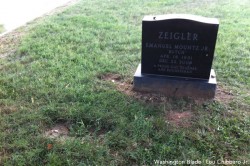
Before being removed earlier this year from this gravesite, the head and foot stones for Frank Kameny were located to the left and in front of head stone shown here, which marks the grave of another person. (Blade photo by Lou Chibbaro Jr.)
However, when reached two days later by phone, Carter told the Blade Williams had just informed him he had a proposal to resolve the dispute but that Williams did not provide any details about the proposal. Carter said Williams told him he would take steps to provide those details soon.
“HOBS has always been willing to work things out,” Carter said. “We’re not interested in continuing to own the gravesite.”
Carter told the Blade in a phone interview on July 29 that he had been out of town for the past few weeks and didn’t have a chance to check mail that may have been sent to HOBS.
“But no one from the estate has called me or emailed me about this recently,” he said. “They have my number and email address.”
Ackerman disputes this assertion, saying he and his law firm repeatedly sent written material to Carter by certified mail. He said the mail was returned to the law firm marked “refused” by recipient.
District of Columbia
Catching up with the asexuals and aromantics of D.C.
Exploring identity and finding community
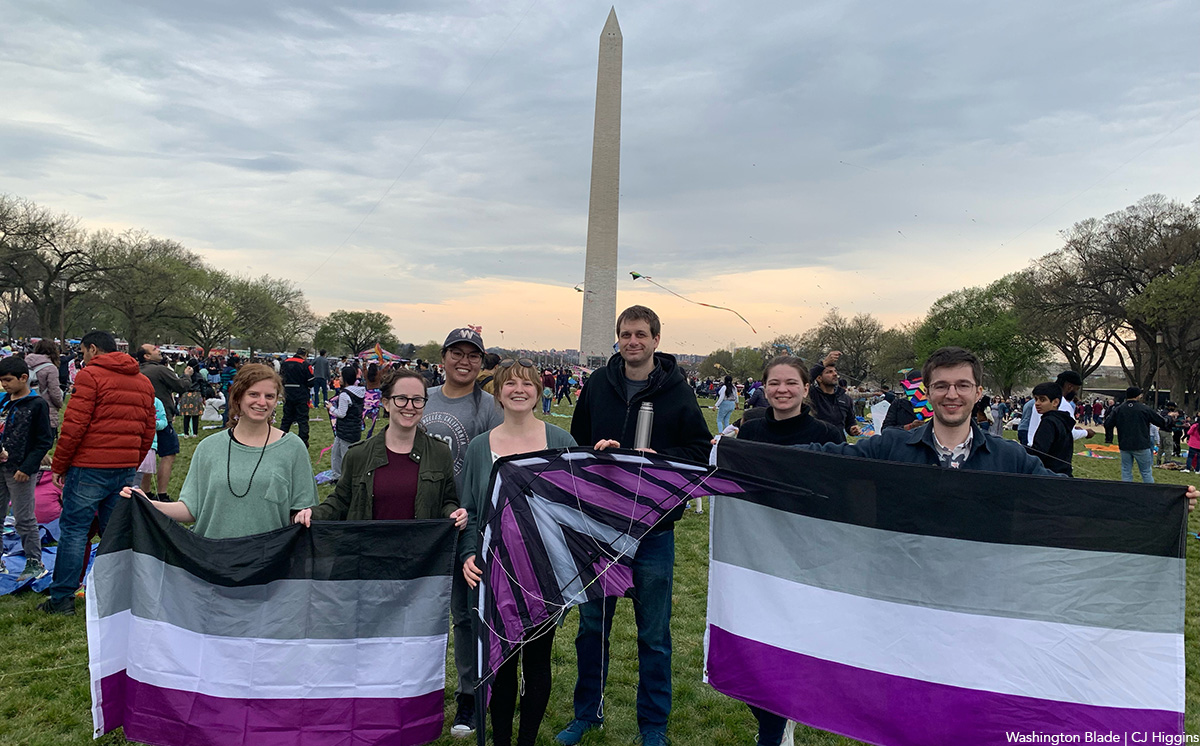
There was enough commotion in the sky at the Blossom Kite Festival that bees might have been pollinating the Washington Monument. I despaired of quickly finding the Asexuals and Aromantics of the Mid-Atlantic—I couldn’t make out a single asexual flag among the kites up above. I thought to myself that if it had been the Homosexuals of the Mid-Atlantic I would’ve had my gaydar to rely on. Was there even such a thing as ace-dar?
As it turned out, the asexual kite the group had meant to fly was a little too pesky to pilot. “Have you ever used a stunt kite?” Bonnie, the event organizer asked me. “I bought one. It looked really cool. But I can’t make it work.” She sighed. “I can’t get the thing six feet off the ground.” The group hardly seemed to care. There was caramel popcorn and cookies, board games and head massages, a game of charades with more than its fair share of Pokémon. The kites up above might as well have been a coincidental sideshow. Nearly two dozen folks filtered in and out of the picnic throughout the course of the day.
But I counted myself lucky that Bonnie picked me out of the crowd. If there’s such a thing as ace-dar, it eludes asexuals too. The online forum for all matters asexual, AVEN, or the Asexual Visibility and Education Network, is filled with laments: “I don’t think it’s possible.” “Dude, I wish I had an ace-dar.” “If it exists, I don’t have it.” “I think this is just like a broken clock is right twice a day type thing.” What seems to be a more common experience is meeting someone you just click with—only to find out later that they’re asexual. A few of the folks I met described how close childhood friends of theirs likewise came out in adulthood, a phenomenon that will be familiar to many queer people. But it is all the more astounding for asexuals to find each other this way, given that asexual people constitute 1.7% of sexual minorities in America, and so merely .1% of the population at large.
To help other asexuals identify you out in the world, some folks wear a black ring on their middle finger, much as an earring on the right ear used to signify homosexuality in a less welcoming era. The only problem? The swinger community—with its definite non-asexuality—has also adopted the signal. “It’s still a thing,” said Emily Karp. “So some people wear their ace rings just to the ace meet-ups.” Karp has been the primary coordinator for the Asexuals and Aromantics of the Mid-Atlantic (AAMA) since 2021, and a member of the meet-up for a decade. She clicked with the group immediately. After showing up for a Fourth of July potluck in the mid-afternoon, she ended up staying past midnight. “We played Cards against Humanity, which was a very, very fun thing to do. It’s funny in a way that’s different than if we were playing with people that weren’t ace. Some of the cards are implying, like, the person would be motivated by sex in a way that’s absurd, because we know they aren’t.”
Where so many social organizations withered during the pandemic, the AAMA flourished. Today, it boasts almost 2,000 members on meetup.com. Karp hypothesized that all the social isolation gave people copious time to reflect on themselves, and that the ease of meeting up online made it convenient as a way for people to explore their sexual identity and find community. Online events continue to make up about a third of the group’s meet-ups. The format allows people to participate who live farther out from D.C. And it allows people to participate at their preferred level of comfort: while many people participate much as they would at an in-person event, some prefer to watch anonymously, video feed off. Others prefer to participate in the chat box, though not in spoken conversation.
A recent online event was organized for a discussion of Rhaina Cohen’s book, “The Other Significant Others,” published in February. Cohen’s book discusses friendship as an alternative model for “significant others,” apart from the romantic model that is presupposed to be both the center and goal of people’s lives. The AAMA group received the book with enthusiasm. “It literally re-wired my brain,” as one person put it. People discussed the importance of friendship to their lives, and their difficulties in a world that de-prioritized friendship. “I can break up with a friend over text, and we don’t owe each other a conversation,” one said. But there was some disagreement when it came to the book’s discussion of romantic relationships. “It relegates ace relationships to the ‘friend’ or ‘platonic’ category, to the normie-reader,” one person wrote in the chat. “Our whole ace point is that we can have equivalent life relationships to allo people, simply without sex.” (“Allo” is shorthand for allosexual or alloromantic, people who do experience sexual or romantic attraction.)
The folks of the AAMA do not share a consensus on the importance of romantic relationships to their lives. Some asexuals identify as aromantic, some don’t. And some aromantics don’t identify as asexual, either. The “Aromantic” in the title of the group is a relatively recent addition. In 2017, the group underwent a number of big changes. The group was marching for the first time in D.C. Pride, participating in the LGBTQ Creating Change conference, and developing a separate advocacy and activism arm. Moreover, the group had become large enough that discussions were opened up into forming separate chapters for D.C., Central Virginia, and Baltimore. During those discussions, the group leadership realized that aromantic people who also identified as allosexual didn’t really have a space to call their own. “We were thinking it would be good to probably change the name of the Meetup group,” Emily said. “But we were not 100% sure. Because [there were] like 1,000 people in the group, and they’re all aces, and it’s like, ‘Do you really want to add a non-ace person?’” The group leadership decided to err on the side of inclusion. “You know, being less gatekeep-y was better. It gave them a place to go — because there was nowhere else to go.”
The DC LGBT Center now sponsors a support group for both asexuals and aromantics, but it was formed just a short while ago, in 2022. The founder of the group originally sought out the center’s bisexual support group, since they didn’t have any resources for ace folks. “The organizer said, you know what, why don’t we just start an ace/aro group? Like, why don’t we just do it?” He laughed. “I was impressed with the turnout, the first call. It’s almost like we tapped into, like, a dam. You poke a hole in the dam, and the water just rushes out.” The group has a great deal of overlap with the AAMA, but it is often a person’s first point of contact with the asexual and aromantic community in D.C., especially since the group focuses on exploring what it means to be asexual. Someone new shows up at almost every meeting. “And I’m so grateful that I did,” one member said. “I kind of showed up and just trauma dumped, and everyone was really supportive.”
Since the ace and aro community is so small, even within the broader queer community, ace and aro folks often go unrecognized. To the chagrin of many, the White House will write up fact sheets about the LGBTQI+ community, which is odd, given that when the “I” is added to the acronym, the “A” is usually added too. OKCupid has 22 genders and 12 orientations on its dating website, but “aromantic” is not one of them — presumably because aromantic people don’t want anything out of dating. And since asexuality and aromanticism are defined by the absence of things, it can seem to others like ace and aro people are ‘missing something.’ One member of the LGBT center support group had an interesting response. “The space is filled by… whatever else!” they said. “We’re not doing a relationship ‘without that thing.’ We’re doing a full scale relationship — as it makes sense to us.”
CJ Higgins is a postdoctoral fellow with the Alexander Grass Humanities Institute at Johns Hopkins University.
District of Columbia
Bowser budget proposal calls for $5.25 million for 2025 World Pride
AIDS office among agencies facing cuts due to revenue shortfall
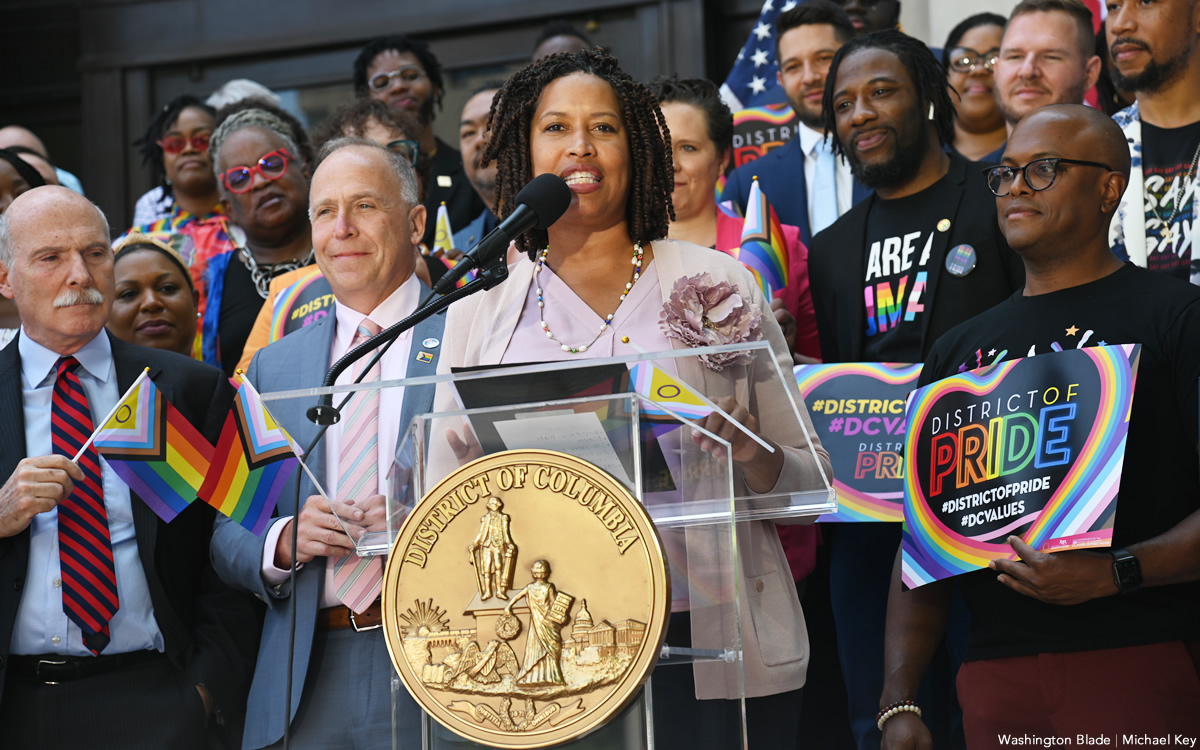
D.C. Mayor Muriel Bowser’s proposed fiscal year 2025 budget includes a request for $5.25 million in funding to support the June 2025 World Pride celebration, which D.C. will host, and which is expected to bring three million or more visitors to the city.
The mayor’s proposed budget, which she presented to the D.C. Council for approval earlier this month, also calls for a 7.6 percent increase in funding for the Mayor’s Office of LGBTQ Affairs, which amounts to an increase of $132,000 and would bring the office’s total funding to $1.7 million. The office, among other things, provides grants to local organizations that provide services to the LGBTQ community.
Among the other LGBTQ-related funding requests in the mayor’s proposed budget is a call to continue the annual funding of $600,000 to provide workforce development services for transgender and gender non-conforming city residents “experiencing homelessness and housing instability.” The budget proposal also calls for a separate allocation of $600,000 in new funding to support a new Advanced Technical Center at the Whitman-Walker Health’s Max Robinson Center in Ward 8.
Among the city agencies facing funding cuts under the mayor’s proposed budget is the HIV/AIDS, Hepatitis, Sexually Transmitted Disease, and Tuberculosis Administration, known as HAHSTA, which is an arm of the D.C. Department of Health. LGBTQ and AIDS activists have said HAHSTA plays an important role in the city’s HIV prevention and support services. Observers familiar with the agency have said it recently lost federal funding, which the city would have to decide whether to replace.
“We weren’t able to cover the loss of federal funds for HAHSTA with local funds,” Japer Bowles, director of the Mayor’s Office of LGBTQ Affairs, told the Washington Blade. “But we are working with partners to identify resources to fill those funding gaps,” Bowles said.
The total proposed budget of $21 billion that Bowser submitted to the D.C. Council includes about $500 million in proposed cuts in various city programs that the mayor said was needed to offset a projected $700 million loss in revenue due, among other things, to an end in pandemic era federal funding and commercial office vacancies also brought about by the post pandemic commercial property and office changes.
Bowser’s budget proposal also includes some tax increases limited to sales and business-related taxes, including an additional fee on hotel bookings to offset the expected revenue losses. The mayor said she chose not to propose an increase in income tax or property taxes.
Earlier this year, the D.C. LGBTQ+ Budget Coalition, which consists of several local LGBTQ advocacy organizations, submitted its own fiscal year 2025 budget proposal to both Bowser and the D.C. Council. In a 14-page letter the coalition outlined in detail a wide range of funding proposals, including housing support for LGBTQ youth and LGBTQ seniors; support for LGBTQ youth homeless services; workforce and employment services for transgender and gender non-conforming residents; and harm reduction centers to address the rise in drug overdose deaths.
Another one of the coalition’s proposals is $1.5 million in city funding for the completion of the D.C. Center for the LGBTQ Community’s new building, a former warehouse building in the city’s Shaw neighborhood that is undergoing a build out and renovation to accommodate the LGBTQ Center’s plans to move in later this year. The coalition’s budget proposal also calls for an additional $300,000 in “recurring” city funding for the LGBTQ Center in subsequent years “to support ongoing operational costs and programmatic initiatives.”
Bowles noted that Bowser authorized and approved a $1 million grant for the LGBTQ Center’s new building last year but was unable to provide additional funding requested by the budget coalition for the LGBTQ Center for fiscal year 2025.
“We’re still in this with them,” Bowles said. “We’re still looking and working with them to identify funding.”
The total amount of funding that the LGBTQ+ Budget Coalition listed in its letter to the mayor and Council associated with its requests for specific LGBTQ programs comes to $43.1 million.
Heidi Ellis, who serves as coordinator of the coalition, said the coalition succeeded in getting some of its proposals included in the mayor’s budget but couldn’t immediately provide specific amounts.
“There are a couple of areas I would argue we had wins,” Ellis told the Blade. “We were able to maintain funding across different housing services, specifically around youth services that affect folks like SMYAL and Wanda Alston.” She was referring to the LGBTQ youth services group SMYAL and the LGBTQ organization Wanda Alston Foundation, which provides housing for homeless LGBTQ youth.
“We were also able to secure funding for the transgender, gender non-conforming workforce program,” she said. “We also had funding for migrant services that we’ve been advocating for and some wins on language access,” said Ellis, referring to programs assisting LGBTQ people and others who are immigrants and aren’t fluent in speaking English.
Ellis said that although the coalition’s letter sent to the mayor and Council had funding proposals that totaled $43.1 million, she said the coalition used those numbers as examples for programs and policies that it believes would be highly beneficial to those in the LGBTQ community in need.
“I would say to distill it down to just we ask for $43 million or whatever, that’s not an accurate picture of what we’re asking for,” she said. “We’re asking for major investments around a few areas – housing, healthcare, language access. And for capital investments to make sure the D.C. Center can open,” she said. “It’s not like a narrative about the dollar amounts. It’s more like where we’re trying to go.”
The Blade couldn’t’ immediately determine how much of the coalition’s funding proposals are included in the Bowser budget. The mayor’s press secretary, Daniel Gleick, told the Blade in an email that those funding levels may not have been determined by city agencies.
“As for specific funding levels for programs that may impact the LGBTQ community, such as individual health programs through the Department of Health, it is too soon in the budget process to determine potential adjustments on individual programs run though city agencies,” Gleick said.
But Bowles said several of the programs funded in the mayor’s budget proposal that are not LGBTQ specific will be supportive of LGBTQ programs. Among them, he said, is the budget’s proposal for an increase of $350,000 in funding for senior villages operated by local nonprofit organizations that help support seniors. Asked if that type of program could help LGBTQ seniors, Bowles said, “Absolutely – that’s definitely a vehicle for LGBTQ senior services.”
He said among the programs the increased funding for the mayor’s LGBTQ Affairs office will support is its ongoing cultural competency training for D.C. government employees. He said he and other office staff members conduct the trainings about LGBTQ-related issues at city departments and agencies.
Bowser herself suggested during an April 19 press conference that local businesses, including LGBTQ businesses and organizations, could benefit from a newly launched city “Pop-Up Permit Program” that greatly shortens the time it takes to open a business in vacant storefront buildings in the downtown area.
Bowser and Nina Albert, D.C. Deputy Mayor for Planning and Economic Development, suggested the new expedited city program for approving permits to open shops and small businesses in vacant storefront spaces could come into play next year when D.C. hosts World Pride, one of the word’s largest LGBTQ events.
“While we know that all special events are important, there is an especially big one coming to Washington, D.C. next year,” Bowser said at the press conference. “And to that point, we proposed a $5.25 million investment to support World Pride 2025,” she said, adding, “It’s going to be pretty great. And so, we’re already thinking about how we can include D.C. entrepreneurs, how we’re going to include artists, how we’re going to celebrate across all eight wards of our city as well,” she said.
Among those attending the press conference were officials of D.C.’s Capital Pride Alliance, which will play a lead role in organizing World Pride 2025 events.
Maryland
Health care for Marylanders with HIV is facing huge cuts this summer
Providers poised to lose three-quarters of funding
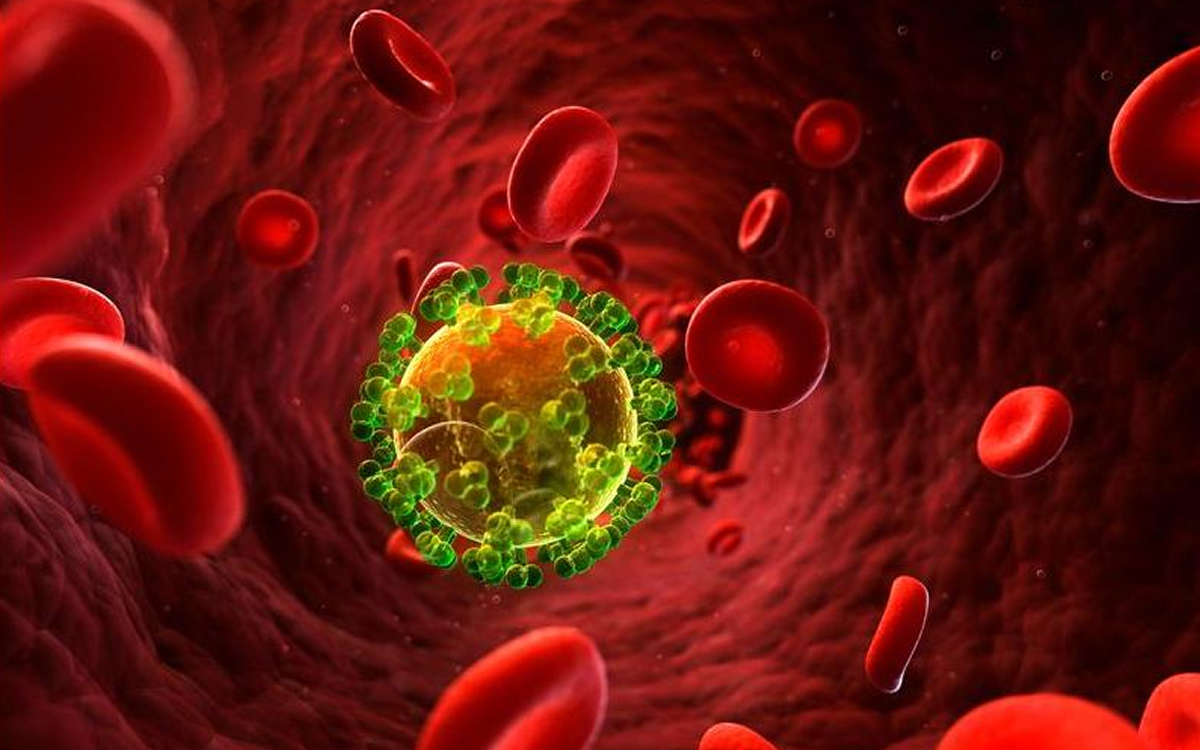
BY MEREDITH COHN | By the end of June, health care providers in Maryland will lose nearly three-quarters of the funding they use to find and treat thousands of people with HIV.
Advocates and providers say they had been warned there would be less money by the Maryland Department of Health, but were stunned at the size of the drop — from about $17.9 million this fiscal year to $5.3 million the next. The deep cuts are less than three months away.
The rest of this article can be read on the Baltimore Banner’s website.
-

 State Department3 days ago
State Department3 days agoState Department releases annual human rights report
-

 Maryland5 days ago
Maryland5 days agoJoe Vogel campaign holds ‘Big Gay Canvass Kickoff’
-

 Politics4 days ago
Politics4 days agoSmithsonian staff concerned about future of LGBTQ programming amid GOP scrutiny
-

 District of Columbia1 day ago
District of Columbia1 day agoCatching up with the asexuals and aromantics of D.C.

